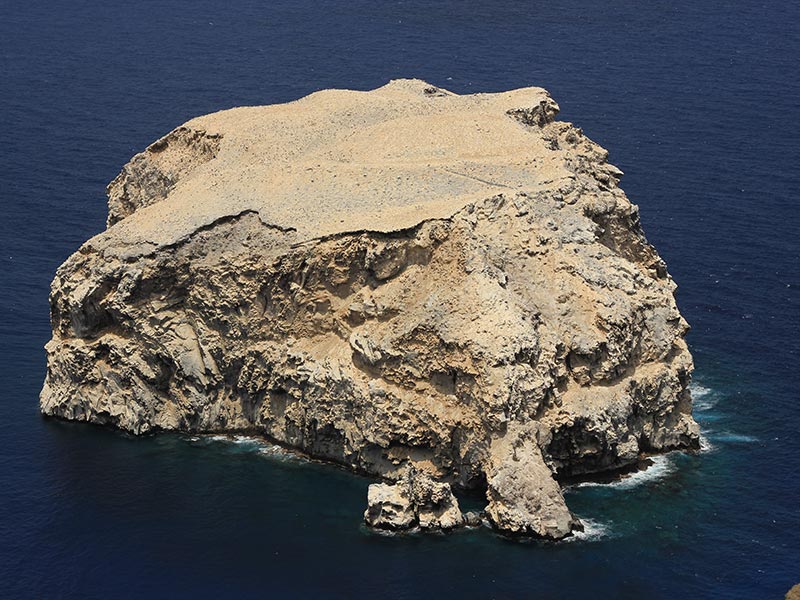Conservation > Explore the Island > Boatswain Bird Island

Boatswain Bird Island (BBI) Sanctuary is a barren, steep island rising to 104m, with a relatively flat top of nearly 3ha, located 300m north of Letterbox peninsula. Birds have nested on the cliffs and plateau for so long that the rock is permanently white from the layers of guano coating the island. Historically, this guano was infrequently mined, once in 1851 and then in the 1920s, but this was a short-lived practice.
This island is an important nesting site for most of the seabird species here on the island. The name boatswain bird is alternate common name given to the red-billed tropicbird, one of the birds to nest on the island, giving the island its name. Other nesting species include storm petrels, white-tailed tropicbirds, red-footed boobies, brown boobies, masked boobies, black noddies, common white terns and Ascension Frigatebirds. In addition to BBI's sanctuary status, it also has been designated an Important Bird Area (IBA) by Birdlife International. The IBA also includes Boatswain Bird rock, a small rock located between letterbox peninsula and BBI.
When human's first started using and then settling Ascension island they brought with them mammalian predators in the form of cats and rodents. These introductions, accidental or not, decimated the bird populations and led to the extinction of the two endemic terrestrial bird species - the Ascension rail and the night heron. The remaining seabirds were forced to nest on offshore stacks, cat inaccessible cliffs and Boatswainbird Island. BBI provided a haven in particular for the Ascension Frigatebird, as it was the only suitable cat inaccessible habitat for this species. Without Boatswainbird Island, we might not have this species alive today. With the eradication of feral cats in 2007, seabirds began to nest again in cat accessible areas, though it took until 2012 before frigatebirds were recorded nesting elsewhere from BBI. Red-footed boobies and storm petrels remain nesting solely on BBI.
BBI is also home to several invertebrates including endemic pseudoscorpions. The immediate waters surrounding BBI have high numbers of young sharks, which suggests that it is an important nursery habitat for Ascension's shark species.
BBI is protected by the National Protected Areas Ordinance 2003. In particular as a sanctuary, it is an offence to land without authority on the island with a penalty of £20,000, 12 months in prison, or both. Steep cliffs and the loss of the landing platform to the sea and made this island almost inaccessible. It is also prohibited to introduce any animal or plant not indigenous to the site. Restricting access is the best possible way to limit introductions and minimise disturbance to this important ecosystem. If you're interested in viewing BBI, it can be viewed by several hikes along the east coast and eastern hills of the island, or by boat.
You can find the following flora and fauna at the Boatswain Bird Island Sanctuary:
Type: Seabird | Status: Vulnerable | Nativeness: Endemic
A large pelagic seabird with predominantly dark plumage and long, slender wings up to 2m in span. Males inflate their characteristic red throat pouches in the breeding season.
Type: Seabird | Status: Least Concern | Nativeness: Native
A pantropical seabird which is slightly smaller than the Masked booby. The upper parts of the bird are a chocolate brown colour whilst the underside is white. The bill, facial skin and legs are a bright yellow colour.
Type: Seabird | Status: Least Concern | Nativeness: Native
A medium sized dark brown seabird with a white crest that blends into a grey neck. These birds are found around the island nesting on rocky outcrops and cliffs.
Type: Invertebrate | Status: Critically Endangered | Nativeness: Endemic
A small, brownish arachnid with a flattened body and large pincer-like pedipalps that contain a poison gland used to subdue their invertebrate prey.
Type: Seabird | Status: Least Concern | Nativeness: Native
The largest and most numerous booby species on Ascension with predominantly white plumage and a distinctive yellow bill and feet. They are found at Letterbox Nature Reserve nesting densely on the plateau.
Type: Seabird | Status: Least Concern | Nativeness: Native
A large white seabird with stunning red feet that only nests on Boatswainbird Island. This booby comes in two colour morphs on Ascension, one brown, and one white, though both will have white tails.
Type: Seabird | Status: Least Concern | Nativeness: Native
A tropical seabird that is mostly white with a black eye strip, diagonal black bars across the wings as well as black wing tips. Their long white tail streamers are a distinctive feature mid-flight.
